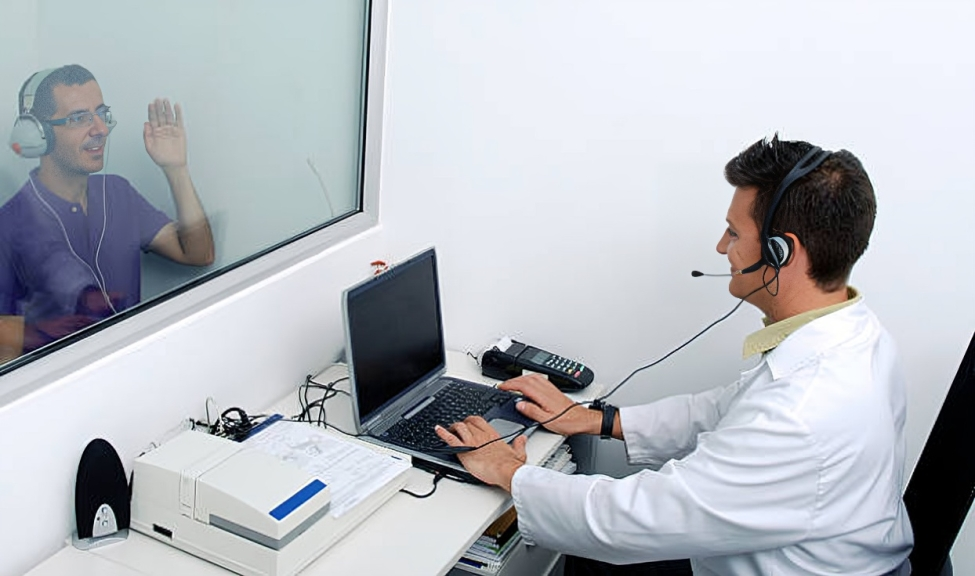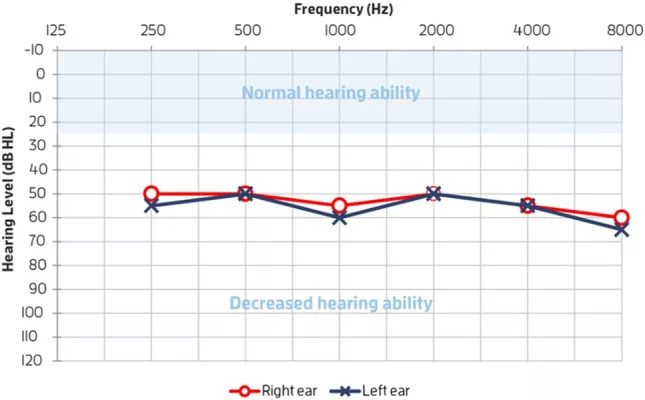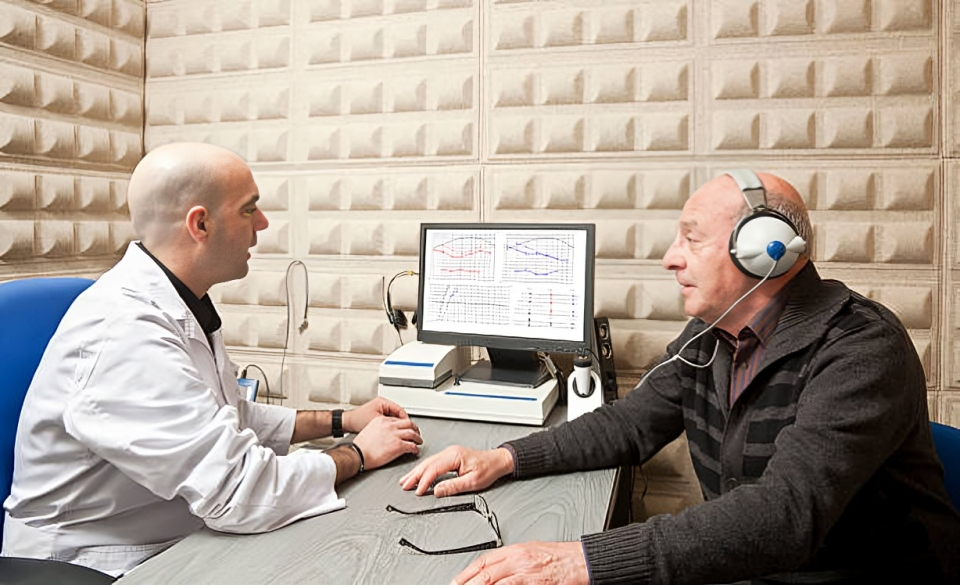Pure Tone Audiometry is a gold standard investigation for detecting the degree and type of hearing loss in adults and children with ages greater than 4 years. It measures the hearing ability of your auditorily system. Pure tone audiometry is a behavioral test and its result depends upon your response to the given stimuli. It involves your peripheral and central auditory system.
What Is Audiometry?
Commonly known as the hearing test, audiometry is a simple and painless evaluation test that checks how well you can identify sounds of different qualities, amplitudes (loudness), and frequencies. The main aim of the test is to identify the least audible (softest) sound for an individual. The softest sound’s loudness is measured in decibels (dB), while the frequency is expressed in hertz (Hz). Loudness explains how high-pitched the sound is, while frequency shows how many sound waves are there in a given time. The audiologist compares the softest sound measured by audiometry to the normal hearing range of an individual of that age for diagnostic purposes.
Hearing loss is a chronic illness affecting the population globally regardless of their age, race, and ethnicity. In the United States of America (USA), it affects over 25 million people aged 12 years or older. It also affects children with a ratio of 1 to 5 children.
Due to a lack of medical awareness, most people do not receive proper medical attention, which leads to permanent hearing loss. However, the treatment depends upon The underlying pathology, type of hearing loss, and degree of severity.1Carl AC, Hohman MH, Cornejo J. Audiology Pure Tone Evaluation. [Updated 2023 Mar 1]. In: StatPearls [Internet]. Treasure Island (FL): StatPearls Publishing; 2024 Jan-. Available from: https://www.ncbi.nlm.nih.gov/books/NBK580531
What is Pure Tone Audiometry?
Pure tone audiometry is a test that helps diagnose issues of the auditory system. It involves introducing audio of a specific frequency to the patient. Audiologists alter the amplitude of the sound to check the softest sound audible to the patient at that frequency.
You encounter sounds of varying frequencies in everyday life. Therefore, testing frequencies one at a time gives a better picture of the hearing incapabilities. A single-frequency tone is used to determine the hearing threshold, and it is called a pure tone.
The softest sound that the patient can appreciate 50% of the time is called the Pure-tone threshold. Patient’s hearing abilities are tested (in both ears) on the following frequencies:2Furst, M., & Levine, R. A. (2015). Hearing disorders in multiple sclerosis. Handbook of Clinical Neurology, 129, 649-665.
- 250 Hz
- 500 Hz
- 1000 Hz
- 2000 Hz
- 4000 Hz
- 8000 Hz
In this test, a series of pure tones are presented at different frequencies within your hearing range to develop the profile of the auditory system.
Weber and Rinne tuning fork tests are also useful for screening purposes of hearing but are not specific. However, the Pure tone audiometry test is the investigation of choice for this purpose that determines the degree, and type of hearing loss.
Why is Pure Tone Audiometry done?
It is advised for individuals having hearing problems, trauma to the ear, and otologic disease. The indications of pure tone audiometry include:
- Hearing loss
- Tinnitus
- Vertigo
- Hyperacusis
- Traumatic brain injury
- Presbycusis
- Blast injury
- Children having speech delay3Carl AC, Hohman MH, Cornejo J. Audiology Pure Tone Evaluation. [Updated 2023 Mar 1]. In: StatPearls [Internet]. Treasure Island (FL): StatPearls Publishing; 2024 Jan-. Available from: https://www.ncbi.nlm.nih.gov/books/NBK580531/
Contraindications of Pure Tone Audiometry
Pure-tone audiometry is a behavioral test so it depends upon your behavioral responses to the given stimuli. This is usually seen in children under the age of six months and in patients with neurological impairment. This test is also contraindicated if the received responses are not unreliable and the patient has a malingering or factitious disorder. Therefore, this test is advised only for adults or older people who can respond well to stimuli.
Types of Hearing Loss:
There are three types of hearing loss, depending on the underlying etiology.
Conductive Hearing Loss
In conductive hearing loss, you have normal bone conduction but abnormal air conduction by 10 dB HL.
Sensorineural Hearing Loss
Sensorineural hearing loss occurs when there is damage to your nerve. It causes permanent hearing loss.
Mixed Hearing Loss
In this, you have both conductive and sensorineural hearing loss.
Types of Pure Tone Hearing Tests:
Pure tone audiometry involves two tests. These include the following:
Threshold hearing test:
In the threshold hearing test, different frequencies of sounds are presented to your ear to determine the degree of hearing loss. It is marked by the last sound that you hear.
Superluminal (high-frequency pure tone audiometry) test:
In this test, the fatigability of your ears is checked by presenting the sound above your threshold level. This Test is carried out under three parameters including:
- Duration
- Intensity
- Frequency
The Procedure of Pure Tone Audiometry
There are some pieces of equipment that are necessary for proceeding with pure tone audiometry.
These include:
- Headphone
- Insert earphone
- Speakers
- Bone-conduction oscillator

Technique:
In this examination, the patient sits in a quiet environment or sound-absorbing environment so external sound can not interrupt the finding. The doctor or audiologist explains all the procedures to the patients and takes consent. Before the test, your doctor will describe the steps of the test before you so that you can respond well. The instructions before commencing the procedure include:
Air conduction
In air conduction testing, the tone of selected frequencies is presented to the ear through the external ear canal. The testing can be performed with headphones, an insert phone, or by creating a sound field. Headphones are placed over the head and usually fit around the ear to reduce environmental noise. Insert earphones can also be used. The signal from the wire enters you through this earpiece. A sound field is created around the patient at an angle of 45 degrees. Usually, this type of air conduction is done in children toddlers, and other individuals in which earphones can not help.
Instructions for Pure Tone Audiometry:
- Tell the patient that a headphone will be placed on your head and a tone of selected frequencies will be presented to the external air at one time in one ear
- Ensure the patient that this test is used to check the ability of your auditory system
- Tell the patient to click the button or raise his finger when he listens to the sound or tone
- Initially, the threshold of the tone is louder so the patient Can listen to it clearly. With time, the sound threshold becomes soft.
- Before starting the procedure,e ensure that the patient is responding well to your stimuli. If he is not responding correctly, stop the procedure and repeat it.4Davies R. A. (2016). Audiometry and other hearing tests. Handbook of Clinical Neurology, 137, 157–176. https://doi.org/10.1016/B978-0-444-63437-5.00011-X
Bone Conduction
In this type, the sound signals travel from the bone of the skull to the cochlea and then into your auditory system. Bone conduction does not involve your external and middle ear.
The doctor places a small oscillator (usually a tunic fork) over the bone, usually mastoid bone that creates oscillations and stimulates the cochlea.
Crossover
Crossover can occur when the sound from the test ear is perceived by the non-test ear. It happens when the testing ear has less hearing than the non-non-testing ear. Therefore, sound from the diseased ear is heard by the ear with better hearing, giving false results on the audiogram. This usually occurs when the doctor uses headphones during the procedure. Therefore, inserting earphones reduces the effect of crossover.
Masking
Sound signals can travel from the test ear to the non-test ear and can give false results. To reduce this crossover, your doctor will apply the masking effect. In masking, he will present the non-test ear with the noise to keep it occupied during the evaluation of the test ear. During the procedure, he will ask the patient to ignore the sounds coming from the non-test ear.5Facs, J. W. K. J. M. (n.d.). Audiology Pure-Tone Testing: Overview, Indications, Contraindications. https://emedicine.medscape.com/article/1822962-overview#a8
How to do a Pure-Tone Audiogram?
A pure-tone audiogram is done in the following steps. It is performed by an experienced clinician under strict protocols. The steps of a pure-tone audiogram include:
Step 1:
First, connect the audiometer with the power supply and make sure that the switch is on
Step 2:
Connect the earphones to the device and place them on the patient’s head in such a way that they cover both ears of the patient to avoid ambient noise. Avoid entry hairs in the earphones that may affect your readings. For this purpose, you can insert earphones.
Step 3:
First, select the higher frequency so everyone can listen to it better, and decrease it gradually
Step 4:
A sound of 30 dB HL is first presented to the patient’s ears through headphones. If he responded, it meant that the 30 dB sound was above the patient’s hearing threshold. However, if the patient is not responding, then increase it to 50 dB HL and then increase it by 10 dB HL until the response is obtained.
Step 5:
Once the patient responds to the given stimuli, decrease the sound by 10 dB until the patient stops responding. After that, increase the sound by 5 dB until the patient responds again, and then decrease it by 5 dB until he stops responding. This sound is reported as the lowest frequency sound that a patient hears. This method is known as the Hughson-Westlake method.
Step 6:
Decrease the frequency by 500 hz and repeat the procedure steps. Then, switch the frequency to 250 Hz and 125 Hz and repeat the steps again.
Step 7:
Compare the results. If the difference between the two thresholds is less than or equal to 5db, then it is satisfactory. However, if the result between the two thresholds is more than 10 dB, then the procedure should be repeated.
Step 8:
Proceed with the test at 2000, 4000, and 8000 Hz in audiograms at octave frequencies.
Step 9:
The sound signals can travel from one ear to another, for one ear is presented with loud frequencies to make it occupied. This process is known as masking.6Pure Tone Audiometry. (n.d.-c). Interacoustics.com. Retrieved March 26, 2024, from https://www.interacoustics.com/academy/audiometry-training/pure-tone-audiometry/pure-tone-audiometry-introduction
Interpretation Of Results: Pure Tone Audiogram

Understanding your test results is a little tricky! At the end of the procedure, your audiologist will hand over a chart to you. Pure tone audiometry result interpretation is done in the form of a graph. You will see the frequency range of sounds in Hz on the x-axis and the sound intensity in dBs on the y-axis. This is known as the audiogram.
You will see two lines on the graph indicating the hearing potentials of both ears. Two colors (red and blue) represent the ears’ outputs. The normal hearing range of a pure tone audiometry test is less than 25 dB or (0-25 dB).
The results of the pure tone audiometry for different diseases are as follows.
Presbycusis:
It is age-related hearing loss, which most commonly affects the aged population. It usually presents with bilateral symmetrical sensorineural hearing loss. This disease affects the higher frequencies more severely than the lower ones. Word recognition is usually poorer in Presbycusis. On the audiogram, there is a down-sloping line that indicates hearing impairment at higher frequencies.
Otitis Media:
It usually presents with the presence of fluid in the middle ear due to infection or inflammation of the lining of the middle ear cavity that causes conductive Hearing loss. On the audiogram, there is a flat or up-sloping line showing conductive Hearing loss.
Noise-Induced Hearing Loss:
Hearing loss is caused by frequent exposure to high-frequency sounds. Frequent exposure to the noise causes a temporary shift of threshold, or it can be permanent. The degree of hearing loss depends upon The exposure and intensity of the sound. Noise-induced hearing loss is usually bilateral but can be unilateral. It usually presents as sensorineural hearing loss, except in blast injuries that cause trauma to your tympanic membrane, resulting in conductive hearing loss.
Otosclerosis:
It is a slowly progressive disease that causes conductive or mixed hearing loss. In otosclerosis, word recognition is excellent under loud speech on audiograms.
Meniere Disease:
This disease affects your cochlear and vestibular system and is characterized by vertigo, tinnitus, hearing loss, and sensation of aural fullness. It is unilateral and causes sensorineural hearing loss. On pure-tone audiograms, word recognition is poorer. 7Health Jade Team. (2020, August 6). Pure tone audiometry. Health Jade. https://healthjade.net/pure-tone-audiometry/

Degrees of hearing loss according to Pure Tone Audiometry
In pure tone audiometry, your hearing threshold levels are present in decibels of hearing loss (dB HL), and your doctor compares it to normal hearing. The classification of hearing impairment is:
Normal Hearing:
The threshold of normal hearing is about 20 decibels of HL. At this level, your hearing is within normal limits.
Mild/slight Hearing Loss:
In mild hearing loss, you can not hear soft speech.
The threshold for slight hearing loss is between 20-40 decibels of hearing loss.
Moderate Hearing Loss:
This type of hearing loss affects your language development and articulation. The threshold for moderate hearing loss is between 40-70 dB HL.
Severe Hearing Loss :
People with this type of hearing loss can not appreciate conversational speech. The Threshold for severe hearing loss is between 70-90 dB HL.
Profound Hearing Loss:
In this type, there is deterioration of speech and language. The Threshold for profound hearing loss is between 90-120 dB HL.
Complete Hearing Loss (Anacusis):
A threshold greater than 120 dB HL is an indication of complete hearing loss.8Díez, P. (2018, September 26). What is pure tone audiometry? – Blog of Kiversal. Blog of Kiversal. https://blog.kiversal.com/en/what-is-pure-tone-audiometry/
Pure Tone Audiometry vs Tympanometry:
Audiometry is a test that observes your auditory system by presenting sounds of different frequencies to the ears. It helps to distinguish between various types of sounds. This test involves your external, middle, and internal ear. This test is suitable for young patients and children with ages greater than 5 years who can respond well and follow the doctor’s instructions.9HUIZING H. C. (1951). Pure tone audiometry. Acta oto-laryngologica, 40(1-2), 51–61. https://doi.org/10.3109/00016485109138907
Tympanometry is a test that involves only the middle ear and works by measuring the movement of the ear Derma against a given stimuli. This test can be done at any age. It tells us whether there is a fluid in the eardrum or not that is preventing the movement of the eardrum.
Conclusion
To conclude, pure tone audiometry is a gold standard test to detect the extent of hearing loss. It uses different frequencies to record the auditory profile. Indications of pure tone audiometry are presbycusis, hyperacusis, hearing loss, vertigo, tinnitus, delayed speech, traumatic brain injuries, and blast injuries. This is a non-invasive test preferable for patients above 5 years of age.
Refrences
- 1Carl AC, Hohman MH, Cornejo J. Audiology Pure Tone Evaluation. [Updated 2023 Mar 1]. In: StatPearls [Internet]. Treasure Island (FL): StatPearls Publishing; 2024 Jan-. Available from: https://www.ncbi.nlm.nih.gov/books/NBK580531
- 2Furst, M., & Levine, R. A. (2015). Hearing disorders in multiple sclerosis. Handbook of Clinical Neurology, 129, 649-665.
- 3Carl AC, Hohman MH, Cornejo J. Audiology Pure Tone Evaluation. [Updated 2023 Mar 1]. In: StatPearls [Internet]. Treasure Island (FL): StatPearls Publishing; 2024 Jan-. Available from: https://www.ncbi.nlm.nih.gov/books/NBK580531/
- 4Davies R. A. (2016). Audiometry and other hearing tests. Handbook of Clinical Neurology, 137, 157–176. https://doi.org/10.1016/B978-0-444-63437-5.00011-X
- 5Facs, J. W. K. J. M. (n.d.). Audiology Pure-Tone Testing: Overview, Indications, Contraindications. https://emedicine.medscape.com/article/1822962-overview#a8
- 6Pure Tone Audiometry. (n.d.-c). Interacoustics.com. Retrieved March 26, 2024, from https://www.interacoustics.com/academy/audiometry-training/pure-tone-audiometry/pure-tone-audiometry-introduction
- 7Health Jade Team. (2020, August 6). Pure tone audiometry. Health Jade. https://healthjade.net/pure-tone-audiometry/
- 8Díez, P. (2018, September 26). What is pure tone audiometry? – Blog of Kiversal. Blog of Kiversal. https://blog.kiversal.com/en/what-is-pure-tone-audiometry/
- 9HUIZING H. C. (1951). Pure tone audiometry. Acta oto-laryngologica, 40(1-2), 51–61. https://doi.org/10.3109/00016485109138907

